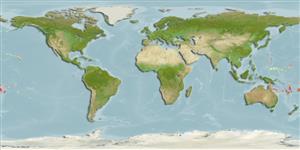Classificação / Names
Nomes comuns | Sinónimos | Catalog of Fishes(Género, Espécies) | ITIS | CoL | WoRMS | Cloffa
>
Ovalentaria/misc (Various families in series Ovalentaria) >
Pomacentridae (Damselfishes) > Pomacentrinae
Etymology: Amblyglyphidodon: Greek, amblys = darkness + Greek, glyphis = carved + Greek, odous = teeth (Ref. 45335); melanopterus: Name from Greek 'melanos' for black and 'pteron' for fin; referring to the black caudal fin and soft portions of the dorsal and anal fins..
More on authors: Allen & Randall.
Environment: milieu / climate zone / depth range / distribution range
Ecologia
marinhas associadas(os) a recifes; intervalo de profundidade 2 - 8 m (Ref. 82240). Tropical
Distribuição
Países | Áreas FAO | Ecossistemas | Ocorrências | Point map | Introduções | Faunafri
Pacific Ocean: known only from Tonga.
Tamanho / Peso / Idade
Maturity: Lm ? range ? - ? cm
Max length : 10.2 cm SL macho/indeterminado; (Ref. 82240)
Espinhos dorsais (total): 7 - 8; Raios dorsais moles (total): 11-13; Espinhos anais 2; Raios anais moles: 11 - 13; Vértebras: 26. This species is distinguished by the following characters: D XII-XIII (rarely XII),11-13; A II,11-13; pectoral rays 16-18; lateral line tubed scales 14-17 (modally 16); gill rakers 8-9 + 22-24 (total, 30-33, modally 31-32); body depth is 1.65-1.8 in SL; teeth are incisiform, in a single row; scaled suborbital; scales dorsally on snout extending well before nostrils, nearly to base of upper lip; colour of dorsal part of head, anterior body and scaled basal part of dorsal fin is light greyish green, scale edges are dusky, shading ventrally and posteriorly to greenish or pinkish white; naked portion of caudal fin and soft portions of dorsal and anal fins are black; pectoral fins with transparent membranes and faintly dusky rays; without black spot at base or axil of pectoral fins; pelvic fins are white (Ref. 82240).
Presumed to be reef-associated (Ref. 46206). Oviparous, distinct pairing during breeding (Ref. 205). Eggs are demersal and adhere to the substrate (Ref. 205). Males guard and aerate the eggs (Ref. 205).
Life cycle and mating behavior
Maturidade | Reprodução | Desova | Ovos | Fecundidade | Larvas
Oviparous, distinct pairing during breeding (Ref. 205). Eggs are demersal and adhere to the substrate (Ref. 205). Males guard and aerate the eggs (Ref. 205).
Allen, G.R. and J.E. Randall, 2002. A review of the leucogaster species complex of the Indo-Pacific pomacentrid genus Amblyglyphidodon, with descriptions of two new species. aqua, J. Ichthyol. Aquat. Biol. 5(4):139-152. (Ref. 82240)
Categoria na Lista Vermelha da IUCN (Ref. 130435)
Ameaça para o homem
Harmless
Utilização humana
Mais informação
Nomes comunsSinónimosMetabolismoPredadoresEcotoxicologiaReproduçãoMaturidadeDesovaAgregação para desovaFecundidadeOvosDesenvolvimento dos ovos
Idade/TamanhoCrescimentoComprimento-pesoComprimento-comprimentoFrequência de comprimentoMorfometriaMorfologiaLarvasDinâmica larvarRecrutamentoAbundânciaBRUVS
ReferênciasAquaculturaPerfil para aquaculturaEstirpesGenéticaElectrophoresesHereditariedadeDoençasProcessamentoNutrientsMass conversion
ColaboradoresFotografiasStamps, Coins Misc.SonsCiguateraVelocidadeTipo de nataçãoÁrea branquialOutras referênciasCérebrosVisão
Ferramentas
Relatórios especiais
Descarregue XML
Fontes da internet
Estimates based on models
Preferred temperature (Ref.
123201): 24.9 - 29.2, mean 27.1 °C (based on 163 cells).
Phylogenetic diversity index (Ref.
82804): PD
50 = 0.5005 [Uniqueness, from 0.5 = low to 2.0 = high].
Bayesian length-weight: a=0.02344 (0.01149 - 0.04783), b=2.99 (2.82 - 3.16), in cm total length, based on LWR estimates for this (Sub)family-body shape (Ref.
93245).
Nível Trófico (Ref.
69278): 2.7 ±0.3 se; based on size and trophs of closest relatives
Resiliência (Ref.
120179): Elevada, tempo mínimo de duplicação da população menor que 15 meses (Preliminary K or Fecundity.).
Fishing Vulnerability (Ref.
59153): Low vulnerability (10 of 100).
Nutrients (Ref.
124155): Calcium = 123 [61, 196] mg/100g; Iron = 0.767 [0.454, 1.301] mg/100g; Protein = 18.2 [17.0, 19.3] %; Omega3 = 0.101 [0.058, 0.169] g/100g; Selenium = 17.8 [9.7, 34.9] μg/100g; VitaminA = 97.4 [26.9, 337.0] μg/100g; Zinc = 1.9 [1.3, 2.8] mg/100g (wet weight);
